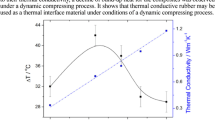Abstract
The structure of a conducting phase of a composite material based on butyl rubber with a dispersed technical carbon filler is analyzed by methods of optical microscopy and scanning and transmission electron microscopy. It is established that the employed production technology ensures homogeneous distribution of technical carbon particles of different structural levels over the rubber matrix. The morphology, phase structure, substructure of ingredients of conducting rubber in different states, and microstructure of the composite material, permitting us to draw a conclusion about electrical conductivity mechanisms, are determined.
Similar content being viewed by others
REFERENCES
T. M. Khalina, Russian Federation Patent No. 2177211, Bull. No. 35 (2001).
T. M. Khalina, V. L. Tarabanov, and S. P. Morozov, Russian Federation Patent No. 2191486, Bull. No. 29 (2002).
T. M. Khalina, Optical and scanning devices and measuring instruments based on them, in: Abstracts of Reports at the All-Union Conf. [in Russian], Barnaul (1990).
V. M. Treboganova, Application of Technical Carbon in Radio Engineering Industry [in Russian], TNIITEneftekhim, Moscow (1979).
G. M. Ronkin, Properties and Application of Butyl Rubber [in Russian], TNIITEneftekhim, Moscow (1969).
K. S. Chernyavskii, Stereology in Metal Research [in Russian], Metallurgiya, Moscow (1977).
A. M. Glauert, ed., Practical Methods in Electron Microscopy, North-Holland Publishing Company, Amsterdam (1972).
G. Schimmel, Electronenmikroskopische Methodik, Springer Verlag, Berlin (1969).
K. W. Andrews, D. J. Dyson, and S. R. Keown, Interpretation of Electron Diffraction Patterns, Hilger and Watts Ltd., London (1967).
G. Tomas and M. J. Goringe, Transmission Electron Microscopy of Materials, John Wiley and Sons, New York (1979).
É. V. Kozlov, Yu. F. Ivanov, N. A. Koneva, and L. N. Ignatenko, in: Functional-Mechanical Property of Materials and Their Modeling [in Russian], Pskov (1993), pp. 90–99.
Author information
Authors and Affiliations
Additional information
Translated from Izvestiya Vysshikh Uchebnykh Zavedenii, Fizika, No. 10, pp. 38–47, October, 2004.
Rights and permissions
About this article
Cite this article
Khalina, T.M. Analysis of the structure of a conducting composite material based on butyl rubber for low-temperature composite electrical heaters. Russ Phys J 47, 1004–1014 (2004). https://doi.org/10.1007/s11182-005-0015-3
Received:
Issue Date:
DOI: https://doi.org/10.1007/s11182-005-0015-3




